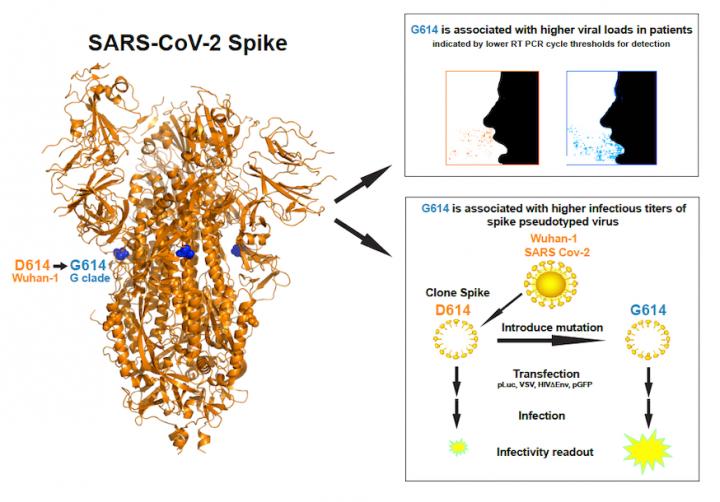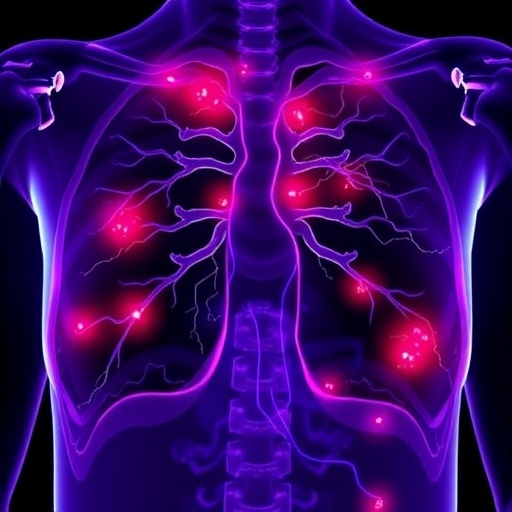Virus with D614G change in Spike out-competes original strain, but may not make patients sicker

Credit: Los Alamos National Laboratory
LOS ALAMOS, N.M., July 2, 2020– Research out today in the journal Cell shows that a specific change in the SARS-CoV-2 coronavirus virus genome, previously associated with increased viral transmission and the spread of COVID-19, is more infectious in cell culture. The variant in question, D614G, makes a small but effective change in the virus’s ‘Spike’ protein, which the virus uses to enter human cells.
Bette Korber, a theoretical biologist at Los Alamos National Laboratory and lead author of the study, noted, “The D614G variant first came to our attention in early April, as we had observed a strikingly repetitive pattern. All over the world, even when local epidemics had many cases of the original form circulating, soon after the D614G variant was introduced into a region it became the prevalent form.”
Geographic information from samples from the GISAID COVID-19 viral sequence database enabled tracking of this highly recurrent pattern, a shift in the viral population from the original form to the D614G variant. This occurred at every geographic level: country, subcountry, county, and city.
Two independent lines of experimental evidence that support these initial results are included in today’s paper. These additional experiments, led by Professor Erica Ollmann Saphire, Ph.D., at the La Jolla Institute, and by Professor David Montefiori, Ph.D., at Duke University, showed that the D614G change increases the virus’s infectivity in the laboratory. These new experiments, as well as more extensive sequence and clinical data and improved statistical models, are presented in the Cell paper. More in vivo work remains to be done to determine the full implications of the change.
The SARS-CoV-2 virus has a low mutation rate overall (much lower than the viruses that cause influenza and HIV-AIDS). The D614G variant appears as part of a set of four linked mutations that appear to have arisen once and then moved together around the world as a consistent set of variations.
“It’s remarkable to me,” commented Will Fischer of Los Alamos, an author on the study, “both that this increase in infectivity was detected by careful observation of sequence data alone, and that our experimental colleagues could confirm it with live virus in such a short time.”
Fortunately, “the clinical data in this paper from Sheffield showed that even though patients with the new G virus carried more copies of the virus than patients infected with D, there wasn’t a corresponding increase in the severity of illness,” said Saphire, who leads the Gates Foundation-supported Coronavirus Immunotherapy Consortium (CoVIC).
Korber noted, “These findings suggest that the newer form of the virus may be even more readily transmitted than the original form – whether or not that conclusion is ultimately confirmed, it highlights the value of what were already good ideas: to wear masks and to maintain social distancing.”
Research partners from Los Alamos National Laboratory, Duke University, and the University of Sheffield initially published work on this analysis on the bioRxiv site in an April 2020 preprint. That work also included observations of COVID-19 patients from Sheffield that suggested an association of the D614G variant with higher viral loads in the upper respiratory tract.
“It is possible to track SARS-CoV-2 evolution globally because researchers worldwide are rapidly making their viral sequence data available through the GISAID viral sequence database”, Korber said. Currently tens of thousands of sequences are available through this project, and this enabled Korber and the research team to identify the emergence of the D614G variant.
GISAID was established to encourage collaboration among influenza researchers, but early in the epidemic the consortium established a SARS-CoV-2 database, which soon became the de facto standard for sharing outbreak sequences among researchers worldwide.
###
The study, “Tracking changes in SARS-CoV-2 Spike: evidence that D614G increases infectivity of the COVID-19 virus” (DOI: 10.1016/j.cell.2020.06.043) was supported by the Medical Research Council (MRC) part of UK Research & Innovation (UKRI the National Institute of Health Research (NIHR); Genome Research Limited, operating as the Wellcome Sanger Institute; CoVIC, INV-006133 of the COVID-19 Therapeutics Accelerator, supported by the Bill and Melinda Gates Foundation, Mastercard, Wellcome; private philanthropic support, as well as the Overton family; a FastGrant, from Emergent Ventures, in aid of COVID-19 research; and the National Institute of Allergy and Infectious Diseases, National Institutes of Health, Department of Health and Human Services, under Interagency Agreement No. AAI12007-001-00000, and the Los Alamos Laboratory Directed Research and Development program.
Additional study authors included S. Gnanakaran, H. Yoon, J. Theiler, W. Abfalterer, N. Hengartner, E.E. Giorgi, T. Bhattacharya, B. Foley, K.M. Hastie, M.D. Parker, D.G. Partridge, C.M. Evans, T.M. Freeman, T.I. de Silva, C. McDanal, L.G. Perez, H. Tang, A. Moon-Walker, S.P. Whelan, C.C. LaBranche.
About Los Alamos National Laboratory
Los Alamos National Laboratory, a multidisciplinary research institution engaged in strategic science on behalf of national security, is managed by Triad, a public service oriented, national security science organization equally owned by its three founding members: Battelle Memorial Institute (Battelle), the Texas A&M University System (TAMUS), and the Regents of the University of California (UC) for the Department of Energy’s National Nuclear Security Administration.
Los Alamos enhances national security by ensuring the safety and reliability of the U.S. nuclear stockpile, developing technologies to reduce threats from weapons of mass destruction, and solving problems related to energy, environment, infrastructure, health, and global security concerns.
Media Contact
Nancy Ambrosiano
[email protected]
Original Source
https:/
Related Journal Article
http://dx.




